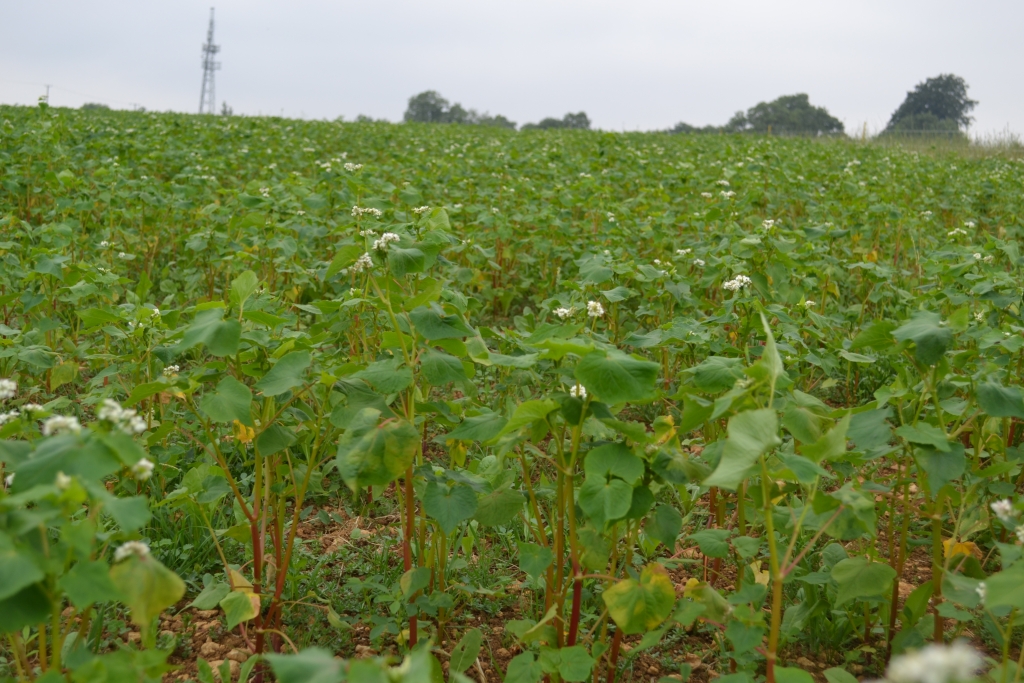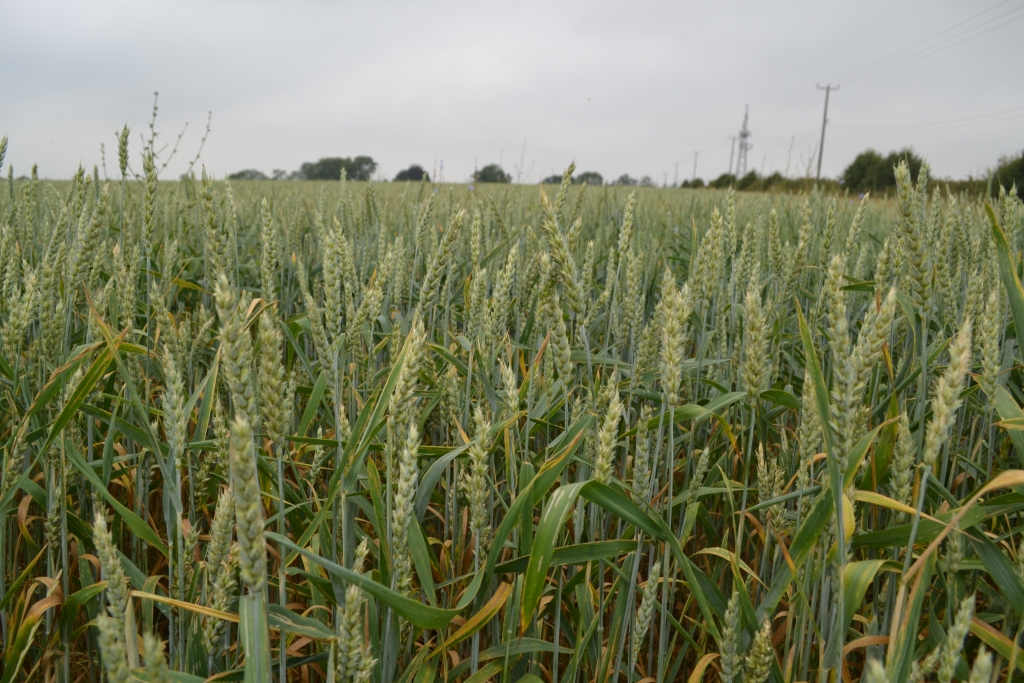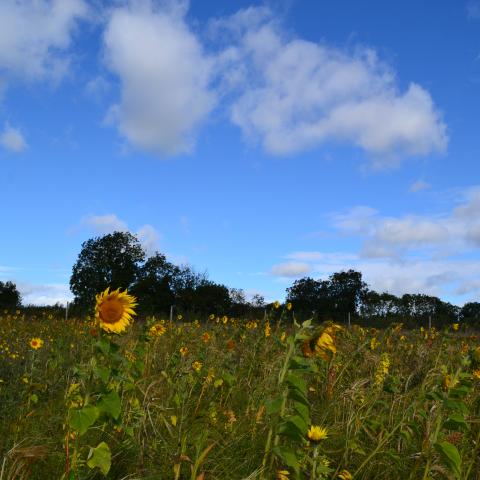Cotswold Seeds purchased the farm in 2013 with aim of developing it as a centre for farming diversity, demonstrating how small family farms can use sustainable farming practices whilst maintaining a respectable income. The single most important factor in achieving this goal is improving and maintaining soil quality.
We’re experimenting and trialling different methods of diverse farming and techniques to improve soil fertility, trying to find new ways of making smaller farms viable by growing diverse crops and having more livestock on the farm so it’s self sufficient, the need for fertilisers and pesticides is avoided, and value is added to commodity foods like oats, wheat and milk.
At the heart of Honeydale is an 8 year crop rotation which begins with a 4 year deep rooting herbal ley. This is the engine of our rotation, which will power the rest of it, improving sustainability and animal health, boosting soil fertility and ultimately driving the profitability of the farm. The mixture of plants contained in the ley brings multiple benefits. After 4 years, the ley is ploughed and followed by turnip and rape. Wheat is then planted and undersown with yellow trefoil and white clover as an intercrop which acts as a soil improver, to be grazed with sheep after the wheat has been harvested. Oats are then sown, followed by a westerwold and vetch, then in year 7 a wild birdseed mix, followed by a phosphate-releasing buckwheat crop which is undersown with the 4 year deep rooting ley.
We have 90-100 Highlander ewe lambs on the farm, which belong to a neighbouring farmer, and are grazed on the permanent pasture and on the herbal leys as a management tool.
Currently, cereals we produce are being used by a local farmer for livestock feed, however, we aim to explore how we can add value to the cereals.
We’re also creating what we believe will be a unique heritage orchard at Honeydale, complete with all the old Oxfordshire varieties of fruit trees and including some rare and unusual apple varieties. We have always wanted to create an orchard and when we met with Andy Howard from the Heritage Fruit Tree Company near Banbury a couple of years ago our dream came into fruition – quite literally! Andy spent two years hand-grafting dozens of regional species so that we had 250 trees to plant. These include 144 apples and 35 cherries, plus apricot, damson, gage, mulberry, nectarine, peach, pear, plum, quince and nectarine. The varieties include the historic Old Fred, Red Army and Blenheim Orange found at Woodstock, Oxfordshire in about 1740, the original kernel planted by tailor George Kempster. We also have the Belle de Boskoop which originated in the Netherlands as a chance seedling in 1856, and the more recent Deddington Pippin, propagated by Andy Howard in 2000 and featured on BBC 4’s ‘Apples’ programme.
The orchard has been planned to provide edible fruit all year as well as attract wildlife, adding to the rich diversity we plan for the farm, with a range of agricultural and horticultural projcts to provide a unique blend of products and interests. We are missing just two varieties for our orchard – the Oxfordshire Greening and Corrie Washer – which Andy is tracking down for us and hopes to be able to plant soon.


Sustainability in practice
Using herbal leys and mob grazing to help build soil fertility
We use herbal leys and mob grazing with sheep to build soil fertility on poor ‘Cotswold Brash’ ahead of an arable rotation.
A herbal ley is a complex mixture of grasses, legumes and herbs, which bring a range of benefits to forage, livestock health and soil fertility. Herbal leys can often include a mixture of up to 17 species, depending on the aims of the ley, location and soil type. In mixes, grasses provide carbohydrates and clovers contribute protein. However, adding forage herbs such as chicory, ribgrass and burnet improves the quantities of vital minerals in the forage which helps increase liveweight gains and milk production. Just as vital is their ability to build soil fertility, withstand drought and promote biodiversity across whole fields. Legume and herb rich swards also improve farm biodiversity, producing food for farmland birds and pollinators, creating habitats for mammals and increased soil quality that not only improves carbon sequestration but also increases soil life, particularly earthworms. The farm now supports 14 hives which will be further sustained by the 10 acre orchard planted with heritage fruit trees.

Sheep grazing a soil improving diverse herbal ley
The sheep are moved daily with roughly 100 ewes given a third of an acre per day. They graze approximately one third of the plants, trampling and treading in the rest. This concentrates dung and urine evenly before the sheep are moved on to the next plot. The grazed plants have a lot of leaf left so they are able to regrow quickly after.
We are still in the fertility building phase at the moment (year 3 of 4 year). But we have started to look at worm counts and have discussed dung beetle counts. We will also measure organic matter from baseline surveys taken three years ago.
As the animals are healthy, no anthelmintics are used in the system and dung beetles break down dung quickly before the sheep return to the plot 30 – 50 days later. When the sheep are moved to the next plot the electric fence is drawn behind them to stop them returning to the grazed area. Herbal leys are a well established type of ley which is once again becoming popular in our time as they are largely self-sufficient and very healthy forage for livestock as well as being more reliable on dry land farms. Mob grazing is now possible for many farmers without permanent fencing as mobile electric fencing is readily available. The provision of water has been a challenge for us as the sheep are moved daily, but lightweight surface alkathene pipe and low pressure water troughs have been a simple solution. Occasionally, in hot weather the sheep are moved to shaded areas which are absent in our open field arable system.
Motivations
I studied farm and grassland management at Berkshire College of Agriculture and joined Cotswold Seeds, a family business based in Moreton-in-Marsh, 30 years ago… The fundamental focus of the business is providing a bridge between farmers and the scientific community. and if there is one man who has inspired and influenced the work of Cotswold Seeds and guided product development it’s Robert Elliot, a pioneering farmer and author who pioneered deep rooting, herbal leys and believed in ‘health from the soil up.’
Cotswold Seeds has built its reputation on developing forage, herbal leys, green manures and complex seed mixtures to improve soil health, animal health and ultimately human health through the food chain. It’s always been part of my vision for the business to have a farm and three years ago, Cotswold Seeds acquired Honeydale Farm, 107 acres in the Cotswolds, which is being developed as a centre for food and farming diversity.

Bird food mixture with sunflowers
As farmers we are custodians of the land and we can’t keep taking from it without putting something back, but the beauty of diverse farming is that it’s a win-win system. For instance, planting trees and hedges provides shelter, making it easier to bring livestock back onto arable land. This in turn enhances the soil, adding value to food products and at the same time creating a habitat for farmland birds and beneficial insects, such as bees.

Sainfoin playing host to a bumblebee
The dilapidated farm buildings will be redeveloped into a centre for farming diversity, enabling people to see first-hand what a sustainable system looks like and what it can achieve. One example is a plan to create a micro-dairy, with five or six cows, to allow people to see close up, and safely, the rudiments of milk production, presenting consumers with a different vision to that of mega-dairies and their associated welfare concerns.
Farmer tips
- Share your neighbour’s equipment to avoid under-utilised capital equipment.
- Make sure that your leys are in the ground long enough to develop deep root structures – 3-5 years.
- Shallow plough or shallow cultivate to keep as much topsoil on top as you can or you’ll lose what you’ve built.
You can find out more about activities at Honeydale Farm by following their blog.
You can find other content on Agricology in relation to Honeydale Farm and Cotswold Seeds:
- The Innovative Farmers webinar ‘Making the Most of Green Manures‘
- The article ‘Herbal Leys‘
- The Soil Association report ‘Digging the Dirt on Honeydale Farm‘
- The video ‘Forage Legumes: Difficult for Farmers to resist?‘
- Ian Wilkinson’s blog ‘Companion crops are a farmer’s friend‘
- The video ‘Cotswold Seeds First Hand: Herbal Leys with Alex Joynson‘
- The guide ‘The Herbal Ley Farming System‘
- The guide ‘Sort out your soil‘
- The video ‘Introducing The LegumePlus Project: Sainfoin, Birdsfoot Trefoil & Red Clover‘
- The guide ‘Sainfoin: Surprising Science behind a Forgotten Forage‘
- The Agricology Vlog for August 2019 ‘Herbal Leys‘
All images courtesy of Honeydale Farm
